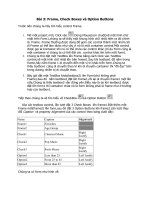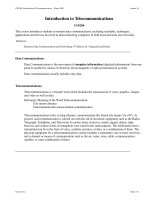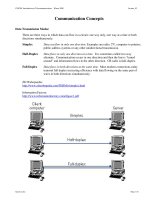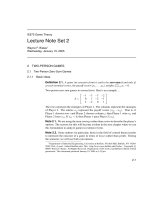03 lecture ppt
Bạn đang xem bản rút gọn của tài liệu. Xem và tải ngay bản đầy đủ của tài liệu tại đây (3.09 MB, 54 trang )
Chapter 3
Earthquake Geology and
Seismology
Lecture PowerPoint
1
Copyright © The McGraw-Hill Companies, Inc. Permission required for reproduction or display.
•
The Lisbon Earthquake of
1755
Morning of November 1, 1755: Lisbon experienced
two major earthquakes in close succession, the
first of which caused widespread fires and the
second of which caused sea waves which swept
many away
• A few hours later, Lisbon was again shaken by an
earthquake in Fez, Morocco (550 km away)
• 70,000 people killed and 90% of structures
destroyed or damaged
• Changed people’s attitudes about the world
What is an Earthquake?
• An event in which the Earth quakes, and vibrations are
felt or recorded
• Caused by volcanic activity, meteorite impacts, undersea
landslides, explosions of nuclear bombs or most
commonly, by movement of the Earth across a fault
• Fault: fracture in the Earth across which the two sides
move relative to each other
• Stresses build up until
enough to cause rocks to
fracture and shift, sending
off waves of seismic
energy, felt as earthquake
Figure 3.2
Faults and Geologic
Mapping
century recognition that fault movements cause
• 19th
earthquakes led to identification of earthquakehazard belts
• Understanding faults begins with understanding
rock relationships, formalized by Steno:
– Law of original horizontality : sediments
are originally deposited in horizontal layers
– Law of superposition: in undeformed
sequence of sedimentary rock layers, each layer
is younger than the layer beneath it and older
than the layer above it
Faults and Geologic
Mapping
– Law of original continuity : sediment layers are
continuous, ending only against a topographic high, by
pinching out from lack of sediment, or by gradational
change from one sediment to another
• If sedimentary layer ends abruptly, may have been eroded by
water action or truncated by fault passing through layer
• Identifying truncated sedimentary layers and recognizing their
offset continuation allows determination of fault length
• Length of fault determines size of earthquake possible on fault
(longer fault ruptures create bigger earthquakes)
• Understanding fault offset can also have financial rewards, if
ore-bearing unit exists two different places on either side of fault
(example of gold-bearing gravels 840 km apart in New Zealand)
Faults and Geologic
Mapping
Figure 3.5
Figure 3.4
Types of Faults
• Jointing – brittle lithospheric rocks fracture and crack
• Large stress differential on either side of a fracture results in
movement: fracture becomes a fault
• Movement ranges from millimeters to hundreds of kilometers,
resulting in tilting and folding of layers
• Use strike and dip to describe location in 3D space of deformed
rock layer
Types of Faults
• Use strike and dip to
describe location in 3D space
of deformed rock layer
• Dip: angle of inclination
from horizontal of tilted
layer
• Strike: compass bearing of
horizontal line in tilted layer
Figure 3.7
Types of Faults
Dip-slip faults :
• Dip-slip faults are dominated by vertical movement
• Ore veins often form in fault zones, so many mines are
actually dug out along faults
• Miners refer to the
block beneath them as
the footwall (block
beneath the fault) and
the block above them
as the hangingwall
(block above the
fault)
Figure 3.8
Types of Faults
Dip-Slip Faults:
• Caused by pushing or pulling force
• Where dominant force is extensional (pulling), normal fault
occurs when hangingwall moves down relative to footwall, and
zone of omission results
Figure 3.9
Types of Faults
Dip-Slip Faults:
• Caused by pushing or pulling force
• Where dominant force is compressional, reverse fault occurs
when hangingwall moves up relative to footwall, and zone of
repetition results
Figure 3.10
Types of Faults
Strike-slip faults:
• Dominated by horizontal
movement
• When straddling a fault, if
right-hand side moved
towards you, it is a rightlateral fault
• When straddling a fault, if
the left-hand side has moved
towards you, it is a leftlateral fault
• Convention works in either
direction
Figure 3.11
Types of Faults
Faults are complex zones of breakage with irregular
surfaces, many miles wide and long
• Stress builds up until rupture occurs at weak point and
propagates along fault surface
• Point where rupture first
occurs is hypocenter or
focus
• Point directly above
hypocenter on surface
is epicenter
Figure 3.12
Types of Faults
• Fault rupture is series of events over weeks to months to
years, with largest event referred to as ‘the earthquake’
• Smaller events preceding ‘the earthquake’ are
foreshocks
– Impossible to identify as foreshock until after ‘the
earthquake’ has occurred
• Smaller events after ‘the earthquake’ are aftershocks
Types of Faults
Steps in
Strike-Slip
Faults:
• Earth does not
rupture along
clean, straight
line but with
several breaks
that stop and start
• and
Leftbend
step in right-lateral fault or right
step in left-lateral fault:
– Compression, uplift, hills and
mountains
Figure 3.13
Types of Faults
Steps in StrikeSlip Faults:
• Right step in rightlateral fault or left
step in left-lateral
fault:
– Extension,
downdropping,
basins and
valleys
Figure 3.14
Types of Faults
Transform Faults:
• As oceanic plates spread apart at mid-ocean ridges, they must slide
past other plates, along transform faults
• Transform faults link spreading centers, or connect spreading center
to subduction zone
• Between two spreading centers, transform fault motion is same as
strike-slip fault
• Outside two
spreading centers,
plates are moving
at same rate so
there is no offset –
fracture zone
Figure 3.15
Development of Seismology
•
•
•
•
•
Seismology: study of earthquakes
Earliest earthquake device: China, 132 B.C.
Instruments to detect earthquake waves: seismometers
Instruments to record earthquake waves: seismographs
Capture movement of Earth in three components: north-south,
east-west and vertical
• One part stays as stationary
as possible while Earth
vibrates: heavy mass fixed
by inertia in frame that
moves with the Earth, and
differences between position
of the frame and the mass are
recorded digitally
Figure 3.16
Development of Seismology
Waves:
•
•
•
•
Amplitude: displacement
Wavelength: distance between successive waves
Period: time between waves (= 1/frequency)
Frequency: number of waves in one second
Figure 3.17
Seismic Waves
Seismic waves come in two categories: those that
can pass through entire Earth (body waves) and
those that move near surface only (surface
waves)
• Body waves: faster than surface waves, have short
periods (high frequency – 0.5 to 20 Hz), most
energetic near earthquake hypocenter
• Two types of body waves:
– P waves and S waves
Seismic Waves
P
•
•
•
(primary) waves
Fastest of all waves
Always first to reach a recording station (hence primary)
Move as push-pull – alternating pulses of compression and
extension, like wave through Slinky toy
• Travel through solid, liquid or gas
– Velocity depends on density and compressibility of substance they are
traveling through
– Velocity of about 4.8 km/sec for P wave through granite
– Can travel through air and so may be audible near the epicenter
Figure 3.18a
Seismic Waves
S (secondary) waves
• Second to reach a recording station (after primary)
• Exhibit transverse motion – shearing or shaking particles at right
angles to the wave’s path (like shaking one end of a rope)
• Travel only through solids
–
–
–
–
S wave is reflected back or converted if reaches liquid
Velocity depends on density and resistance to shearing of substance
Velocity of about 3.0 km/sec for S wave through granite
Up-and-down and side-to-side shaking does severe damage to buildings
Figure 3.18b
Seismic Waves
Seismic Waves and the Earth’s Interior
• Waves from large earthquakes can pass through the entire Earth and
be recorded all around the world
• Waves do not follow straight paths through the Earth but change
velocity and direction as they encounter different layers
Figure 3.19
Seismic Waves
Seismic Waves and the Earth’s Interior
• From the Earth’s surface down:
– Waves initially speed up then slow at the asthenosphere
– Wave speeds increase through mantle until reaching outer core
(liquid), where S waves disappear and P waves suddenly slow
– P wave speeds
increase
gradually
through outer
core until
increasing
dramatically at
inner core
(solid) Figure 3.19
Seismic Waves
Surface waves:
• Travel near the Earth’s surface, created by body waves
disturbing the surface
• Longer period than body waves (carry energy farther)
• Love waves
– Similar motion to S waves, but side-to-side in horizontal
plane
– Travel faster than Rayleigh waves
– Do not move through air or water









